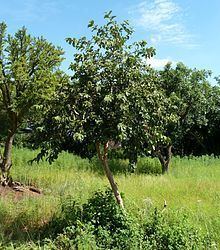Clade Angiosperms Rank Species | ||
 | ||
Similar Vangueria, Vangueria madagascariensis, Ximenia caffra, Strychnos spinosa, Pappea | ||
Vangueria infausta wild medlar or umviyo umlapunzi and natal tree nymph mvi 8505
Vangueria infausta, the medlar or African medlar, is a species of plant in the family Rubiaceae, which is native to the southern and eastern Afrotropics. The fruits are consumed by humans and have a pleasant apple like flavor. The specific name infausta alludes to the misfortune believed to result from its use as firewood.
Contents
- Vangueria infausta wild medlar or umviyo umlapunzi and natal tree nymph mvi 8505
- Description
- Range
- Uses
- References
Description
The trees are low-branching and mostly smallish but may reach 8 m in height. They have drooping branchlets and have pale greyish brown, flaky bark. The fairly large, dull leaves have entire margins and are somewhat variable in shape. They have an opposite arrangement and conspicuous net-veining below. Young leaves are boat-shaped and recurved along the central vein.
Dense clusters of robust green flowers develop from pointed buds in spring. Each velvety flower is about 4 mm long and 6 mm wide, and are carried on opposite and axillary cymes. The corolla is dropped early.
The initially green and glossy fruit appear in summer, and bear the remains of the calyx around their tips. They develop into unevenly shaped, glossy, tan-coloured plums, that contain soft fleshy pulp and fairly large seeds.
Range
This shrub or small tree occurs in abundance in woodlands, scrub, valleys, stony kopjies, or sandy dunes throughout much of Southern and East Africa, including Madagascar. In Africa it is native to Uganda, Kenya, Tanzania, Malawi, Mozambique, Zimbabwe, Namibia, Botswana and South Africa. It may be found from 350 to 1,330 m above sea level.
Uses
The African medlar is a traditional food plant in Africa. This little-known fruit has the potential to improve nutrition, boost food security, foster rural development and support sustainable land care. The fruit are consumed raw or the pulp may be dried and stored for later use, while the seeds may be roasted. Goats and game browse on the leaves, while other animals may consume the fruit on the tree, or after they are shed on the ground. The roots and leaves are used by traditional healers.
Thin twigs are prone to being populated by spittlebugs.
